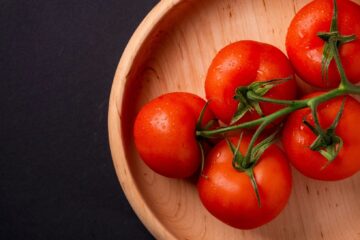 Not all woods burn the same in a fire, do they? The same can be said about foods we put in our ‘digestive fire’. Some burn (or digest) easily, some are more difficult. This important aspect of food often gets overlooked. What you’re eating may on paper be very nutritious but if you can’t digest it, you won’t get to all that goodness. It makes a lot of sense to look at our food in terms of how easy or difficult it is to digest.
Not all woods burn the same in a fire, do they? The same can be said about foods we put in our ‘digestive fire’. Some burn (or digest) easily, some are more difficult. This important aspect of food often gets overlooked. What you’re eating may on paper be very nutritious but if you can’t digest it, you won’t get to all that goodness. It makes a lot of sense to look at our food in terms of how easy or difficult it is to digest.
We need a balance of heavy and light foods
There are foods that are hard to digest and foods that are easy. Let’s call them heavy and light[1].
Heavy foods make sure we are satisfied after meals and remain full for longer. Light foods give us easy and quicker access to nutrients.
We need a balance of heavy and light foods. Many of us, however, tend to eat more heavy foods than our digestion can cope with (see if you have signs of this below). As heavy foods slow down the digestion and metabolism, we need to make sure we have only the amount our digestions can deal with.
As a general rule, heavy foods are denser and contain more protein. Cold, dry, hard, raw or unspiced foods tend to be heavy. These foods have more earth element. There are some foods which are so heavy on the digestion they just aren’t worth the bother, with so many easier-to-digest alternatives. These super-heavies are red meat, modern wheat, yogurt and hard cheese.
Foods which are cooked, soft, soupy and warm tend to be light to digest. Adding spices makes a food lighter too. We see these foods as having more air and fire elements.
The information for these food charts has been collated from ancient texts such as Caraka and Bhavaprakasha along with other modern analyses.
*Raw green vegetables take their toll on the digestive fire so best had in small quantities – dark green leaves are easier than more crunchy solid vegetables.
Who needs to reduce heavy foods?
If you find yourself suffering from slow digestion or metabolism, you should reduce the heavy foods you eat.
You should reduce heavy foods if you suffer from:
- weak digestion (signs may include sleepiness or heaviness after eating, problems with bowel movements, wind, bloating, heartburn etc)
- signs of ama (sticky toxins in the body) including lethargy and a coating on the tongue
We also need a balance of building and reducing foods
Food can also be categorised by its anabolic building effect or catabolic reducing effect on the body and tissues.
Building foods are tissue promoting; i.e. ones you’d eat if you want to put on weight or gain bulk.
Conversely, reducing foods are tissue reducing and lightening[2]. These are foods you’d reach for if you were trying to lose weight.
Why am I telling you this? Because you can then choose the best foods for you based on the state of your digestion and your desire to build or reduce tissues.
You can easily choose the right foods for you
Do you have weak digestion and want to lose weight? Or strong digestion and could do with gaining a few kilos?
By looking at foods in terms of heavy/light and building/reducing, you can find the best foods for you.
*Raw green vegetables take their toll on the digestive fire so best had in small quantities – dark green leaves are easier than more crunchy solid vegetables.
If you’re not sure how to analyse yourself but you know something isn’t right, get in touch with a qualified Ayurvedic Practitioner and they can guide you.
Until next time, take care of yourselves.
Kate
Author: Kate Siraj, Ayurvedic Practitioner, BSc Ayurveda, MChem (Oxon), MAPA.
© The Ayurveda Practice
[1] Heavy (guru) and light (laghu) Ca Su 5: 5-6
[2] Building (santarpana ) and reducing (apatarpana) Ca Su 23: 3-4
Top image of multiple fruit and veg thanks to freedigitalphotos.net






6 Comments
Abhish · September 18, 2018 at 12:08
Very nice info about digestive food
which tells what to eat ,what not to eat , from this information we can plan our daily diet
Actually good food gives good health we all know this but still we are doing wrong practice
by following “You’re not what you eat, you’re what you digest” info we will be healthy and fit.
FR · August 9, 2019 at 11:08
Awesome tips regarding diet and intake of heavy and light foods. Thanks for writing such a great blog.
Rahul Bhatnagar · February 5, 2020 at 06:23
Great information about diet. We should follow this diet to maintain our health.
Boost immunity, reduce stress, stay strong - The Ayurveda Practice · March 13, 2020 at 14:32
[…] rice, vegetables, mung beans (split and whole), red lentils, ghee, cooked grains (not wheat). See here for more on heavy versus light […]
Manage your channel blockers - The Ayurveda Practice · June 29, 2021 at 16:26
[…] things are easy to digest and some things are difficult. There are some which are very difficult (abhishyandi). Knowledge of these makes a huge difference […]
Fasting - what does Ayurveda say? - The Ayurveda Practice · February 2, 2024 at 13:22
[…] when properly hungry, we can make a stronger fast by eating lighter. Eating light can be eating lighter foods or less food or both. Favoured light and reducing foods are mung dal/soup, most other pulses, […]